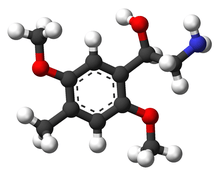BOHD (psychedelic)
 | |
 | |
| Names | |
|---|---|
| IUPAC name
2-amino-1-(2,5-dimethoxy-4-methylphenyl)ethanol | |
| Other names
4-Methyl-2,5-dimethoxy-beta-hydroxyphenethylamine 2-(4-Methyl-2,5-dimethoxyphenyl)ethan-beta-hydroxyamine | |
| Identifiers | |
| |
3D model (JSmol) |
|
| ChemSpider | |
PubChem CID |
|
| |
| |
| Properties | |
| C11H17NO3 | |
| Molar mass | 211.26 g/mol |
Except where otherwise noted, data are given for materials in their standard state (at 25 °C [77 °F], 100 kPa). | |
| Infobox references | |
BOHD (4-methyl-2,5-dimethoxy-beta-hydroxyphenethylamine), is a lesser-known psychedelic drug. It is the beta-hydroxy analog of 2C-D. BOHD was first synthesized by Alexander Shulgin. In his book PiHKAL (Phenethylamines i Have Known And Loved), the minimum dosage is listed as 50 mg, and the duration unknown. BOHD produces a marked drop in blood pressure.[1] Very little data exists about the pharmacological properties, metabolism, and toxicity of BOHD.
Legality
United Kingdom
This substance is a Class A drug in the Drugs controlled by the UK Misuse of Drugs Act.[2]
References
- ↑ Shulgin, Alexander; Ann Shulgin (September 1991). PiHKAL: A Chemical Love Story. Berkeley, California: Transform Press. ISBN 0-9630096-0-5. OCLC 25627628.
- ↑ "UK Misuse of Drugs act 2001 Amendment summary". Isomer Design. Retrieved 12 March 2014.
See also
External links
This article is issued from
Wikipedia.
The text is licensed under Creative Commons - Attribution - Sharealike.
Additional terms may apply for the media files.